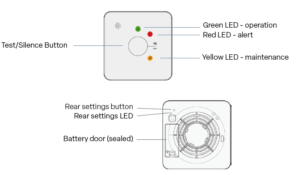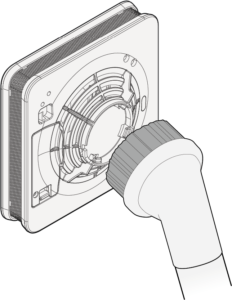All you need to know about your carbon monoxide detector
Your carbon monoxide detector can save your life: get to know it and use it optimally with our advice.

How does my carbon monoxide detector work?
To test the operation of the carbon monoxide detector :
- Press the button on the detector until the alarm signal sounds, then release.
- The alarm buzzer sounds, and the red LED flashes several times a second.
- The detector is operational after 10 minutes
If the test does not work, the detector has probably identified a malfunction. First of all, make sure that you have complied with the precautions and limits for use of the detector.
If so, repeat the operation up to 2 times if necessary.
If the test still doesn’t work, wait 15 minutes and repeat the operation up to 2 times if necessary.
If the test still fails, the detector must be replaced.
At the end of its service life, the carbon monoxide detector reacts as follows:
- Orange indicator light flashes every 60 seconds
- Audible alert beeps 2 times every 60 seconds
The detector is not operational. The detector has been active for more than 10 years, and needs to be replaced.
The detector must not be disposed of with household waste. The detector must be returned to an appropriate collection point for the recycling of electrical and electronic equipment. Observe state disposal laws.
Warning: The detector contains a lithium battery. Do not burn, melt or incinerate the detector.
To pause the carbon monoxide detector when the battery is low :
- Briefly press the sensor button
- The orange indicator light flashes once every 60 seconds for about 12 hours.
The detector is not operational. The detector must be replaced.
Your carbon monoxide detector features red (alarm), orange (maintenance) and green (operation) indicator lights on the front panel, plus a Test/Silence button.
On the back of the product you’ll find the settings button and LED, as well as the battery cover. Your detector is fitted with a sealed 10-year battery: the battery door is locked.
Every year, clean the detector and perform an alarm test:
- Remove the detector from its base
- Turn the detector over
- Remove dust with the brush attachment of a vacuum cleaner, sucking for 30 seconds (any insects, spider webs or dust clusters near the detector must be removed).
- Press the Test / Silence button until the alarm signal sounds, then release.
Warning
Do not use compressed-air sprays or the like
When the battery is low, the carbon monoxide detector reacts as follows:
- Orange indicator light flashes once every 60 seconds for at least 30 days
- Audible alert: 1 beep every 60 seconds for at least 30 days
The detector is not operational. The detector must be replaced.
Every year, test the detector to ensure that the light and sound indicators are working properly.
To stop the current alarm from your carbon monoxide detector :
- Briefly press the central button on the front of the detector
- Red indicator light flashes once every 10 seconds for about 10 minutes
The detector resets automatically after 10 minutes.
When a fault is detected, the carbon monoxide detector reacts as follows:
- Red indicator light flashes once every 60 seconds
- Audible alert beeps 3 times every 60 seconds
The detector is not operational.
Make sure you have complied with the precautions and limits for use of the detector. Clean the back of the detector using the brush attachment of a vacuum cleaner, sucking for 30 seconds.
If the fault alarm persists after 15 minutes, the detector must be replaced.
Pausing the alarm allows you to control a future false alarm in advance (e.g. use of candles or incense, cigarette smoke, etc.). To temporarily pause the carbon monoxide detector :
- Briefly press the sensor button
- Red LED flashes every 10 seconds for about 10 minutes
The detector resets automatically after 10 minutes.
In the event of a carbon monoxide alarm
In case of alarm
A. Keep your cool
B. Open doors and windows
C. Be sure to turn off all fuel-burning appliances you can.
D. Evacuate the premises
E. Once outside, call for help if you suspect carbon monoxide poisoning
F. Call your gas or other fuel supplier, using their emergency number (always have this number handy).
G. Do not return to the dwelling if the audible alarm is still active. As the device is battery-powered, it is important to ensure that the audible alarm has not stopped due to a discharged battery. When re-entering the premises, confirm that the detector is operating correctly.
H. Do not reuse your fuel-burning appliances until an authorized technician or expert has confirmed that they are in good working order.
Suspicion of a false alarm is dangerous because CO is a noxious, invisible, odorless, non-irritating gas, which causes dizziness, vomiting, and ultimately kills within minutes. We recommend that you do not suspect a false alarm and systematically follow the guidelines above (from A to H).
- First familiarize yourself with your detector’s audible alarm.
- Prepare an evacuation plan
- Learn to recognize the exit route
- Practice evacuating your home quickly.

